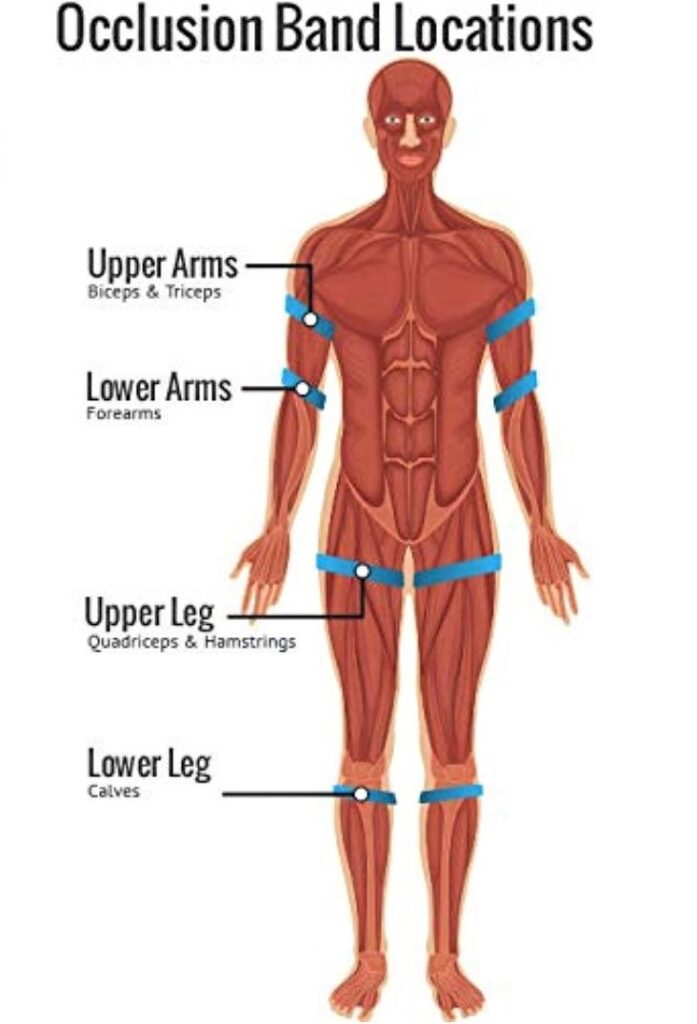Blood flow restriction training might sound like a bad idea. Why would you want to limit the nourishing blood flowing from the muscles you’re training? The short answer is because it may foster more muscle growth and strength gains. Let’s explore the science behind blood flow restriction training—also known as kaatsu training or occlusion training—and delve into its practical implications for your workouts.

WHAT IS BLOOD FLOW RESTRICTION TRAINING?
It works like this: You use a special cuff, wrap, or elastic band to cut off venous blood flow in your arms or legs. The blood pressure in your veins (which removes blood from the limb) is always substantially lower than the blood pressure in your arteries (which brings blood to the limb), so you apply the wrap tight enough to keep blood from leaving the limb while still allowing blood to enter the limb. As a result, you get a crazy great pump, which may have additional strength and growth benefits.
HISTORY OF BLOOD FLOW RESTRICTION TRAINING
The popularity of blood flow restriction training this century makes it seem like the hot new thing. In fact, it originated seven decades ago. It was first envisioned by Dr. Yoshiaki Sato in Tokyo in 1966. He called it kaatsu (meaning “added pressure”). Its adoption in Japan over subsequent decades transformed the effects of traditional athletic training, speed of rehabilitation, and recovery. Kaatsu was first researched in Japan in 1995, and thereafter it gained adoption in the West, where its scientific name is occlusion training.
HOW TO DO BLOOD FLOW RESTRICTION TRAINING
Apply the band or wrap as close to the top of the limb as possible. From a scale of 0 (no pressure) to 10 (extremely uncomfortable pressure), the pressure on your arms should feel like a 7, and on your legs it should feel like an 8.

Use a light weight for the arm or leg exercise, one with which you can get 30-40 reps when you’re fresh. Pump out as many reps as you can, rest for about 30 seconds, and pump out some more reps. This technique is called rest-pause. Do this until you total 60-100 reps per extended rest-pause set. You should be experiencing the best pump you’ve ever had.
For more on such extended sets, see: 100 Reps Per Set: Why and How
SCIENCE OF BLOOD FLOW RESTRICTION TRAINING
Blood flow restriction training creates unique physiological responses within the muscles, which contributes to its potential benefits.
Metabolic Stress and Hormonal Response
During blood restriction training, the restricted blood flow leads to the accumulation of metabolites, including lactic acid, in the muscles. This metabolic stress stimulates the release of anabolic hormones, such as growth hormone and insulin-like growth factor 1 (IGF-1), which play crucial roles in muscle growth and repair [1].
Cellular Signaling and Muscle Adaptations
The low oxygen environment induced by blood restriction training triggers a cascade of cellular signaling pathways within the muscle. These regulate protein synthesis and muscle fiber growth and, combined with metabolic stress, can contribute to increased size and strength [2].
Comparison Study Results
Okay, this all sounds great in theory, but kaatsu has been studied for decades. What do the real world results say about stimulating muscle growth and strength? Researchers have compared BFR training to traditional, heavier weight-training and also combined the two in several studies [3, 4, 5, 6]. Some interesting conclusions can be reached:
1. Low-load BFR training and regular, heavier training are about equivalent for building muscle. This makes BFR training a good substitute for heavier work, especially when recovering from an injury. BFR also provides all the hypertrophy with virtually no muscle damage, so you can recover from workouts faster and work the muscles more often.
2. The results of combining BFR and heavier training were inconclusive. One study showed that combined the two added to hypertrophy; another study showed no upside to this.
3. There were gains in growth and strength in areas other than those below where the cuffs were applied.
4. There were significant gains in strength in the squat and bench press. So, powerlifters and those looking to boost their powerlifts, may want to substitute low-load BFR training for some of their assistance exercises.
FREQUENTLY ASKED QUESTIONS
FAQ: Is blood flow restriction training suitable for everyone?
BFR training is generally safe and can be beneficial for individuals who are healthy and have experience with strength training. However, certain populations, such as people with cardiovascular conditions, high blood pressure, or circulatory disorders, should exercise caution or avoid BFR altogether. And everyone should make certain they’re well-hydrated.

FAQ: How tight should the wrap or BFR device be during training?
It should be tight enough to restrict venous blood flow but still allow arterial blood flow. It’s crucial to not apply excessive pressure that could lead to nerve damage or other complications. Guidelines suggest that the perceived tightness should be around a 7 on the arms and 8 on the legs on a scale in which 10 is maximum (nearly unbearable) discomfort.
FAQ: Can blood flow restriction training replace traditional strength training with heavy weights?
BFR training can be a useful addition to a comprehensive strength training program, but it is not intended to replace traditional strength training entirely. Heavy resistance training with substantial loads is still crucial for maximizing strength and overall muscle development. BFR training can serve as an adjunct and alternative, especially when heavier weights aren’t feasible, such as during injury rehabilitation.
FAQ: Are there any potential risks or side effects to BFR training?
When performed correctly, blood flow restriction training is generally safe. However, there are some risks associated with improper application or misuse of the wrap or blood flow restriction device. These include nerve damage, blood clots, skin irritation, and muscle damage. Therefore, it’s essential to follow proper guidelines and use appropriate caution.
FAQ: How often should blood flow restriction training be performed, and for how long?
The frequency and duration of blood flow restriction training can vary based on individual goals, fitness levels, and training programs. Typically, training sessions may range from two to four times per week, with each session lasting approximately 15 to 20 minutes. You can do all the exercises for a body part with BFR or combine BFR extended sets with regular sets.
FAQ: Can BFR training be combined with N.O. supplements for an even greater pump?
Certainly. You can ingest the N.O. (nitric oxide) supplements citrulline and/or arginine before your workout to enhance your pump.
FAQ: Should I leave the bands tightened for all BFR training or loosen or remove them between BFR sets?
This is a matter of personal preference, as there is no significant difference in results with either approach. If you’re comfortable, you may as well leave them tightened for convenience sake and to keep that maximum pump.

BLOOD FLOW RESTRICTION TRAINING CONCLUSION
Blood flow restriction training has emerged as an innovative approach to muscle growth and strength development. It harnesses the physiological response of restricted blood flow to stimulate anabolic hormone release, provoke metabolic stress, and induce cellular signaling pathways for muscle adaptations. While further research is necessary to fully understand the long-term effects and optimal training protocols, blood flow restriction training offers an effective alternative method for weight-trainers seeking muscle growth and strength gains.
Sources
1. Loenneke, J. P., Wilson, J. M., & Wilson, G. J. (2010), “A mechanistic approach to blood flow occlusion,” International Journal of Sports Medicine, 31(01), 1-4.
2. Abe, T., Kearns, C. F., & Sato, Y. (2006), “Muscle size and strength are increased following walk training with restricted venous blood flow from the leg muscle,” Kaatsu-walk training. Journal of Applied Physiology, 100(5), 1460-1466.
3. Yamanaka, Tatsuo, et al (2012), “Occlusion training increases muscular strength in division IA football players,” J Strength Cond Res, 2012 Sep;26(9):2523-9. link
4. Luebers, Paul E. et al. (2014), “The effects of a 7-week practical blood flow restriction program on well-trained collegiate athletes,” J Strength Cond Res, 2014 Aug;28(8):2270-80. link
5. Lowery, Ryan, et al. (2013), “Practical blood flow restriction training increases muscle hypertrophy during a periodized resistance training programme,” Clinical Physiology and Functional Imaging, Nov. 2013, 34 (4). link
6. Loenneke, Jeremy P., et al. (2012), “Low intensity blood flow restriction training: a meta-analysis,” European Journal of Applied Physiology, vol. 112, p. 1849-1859. link
















































